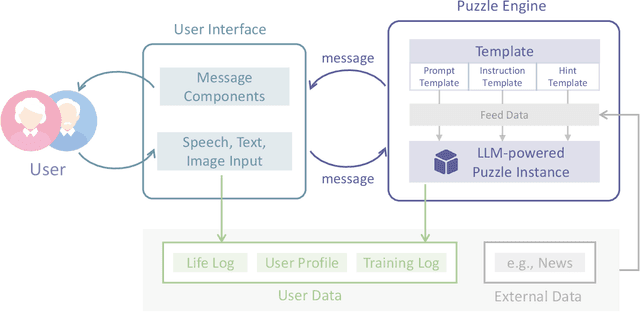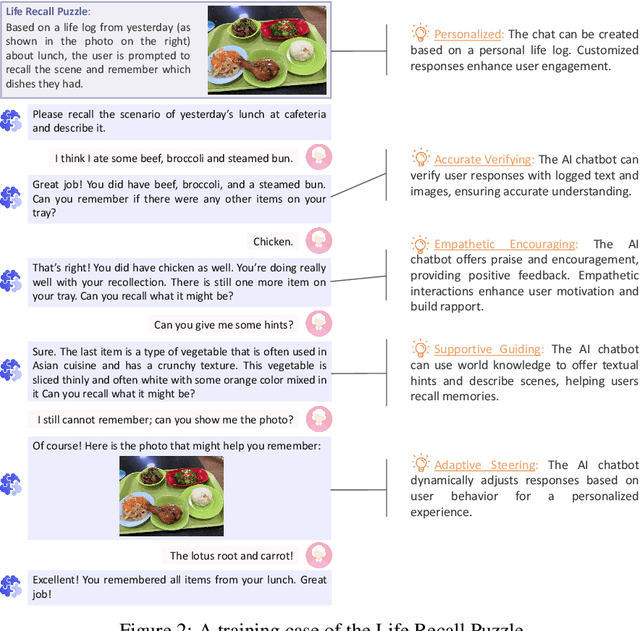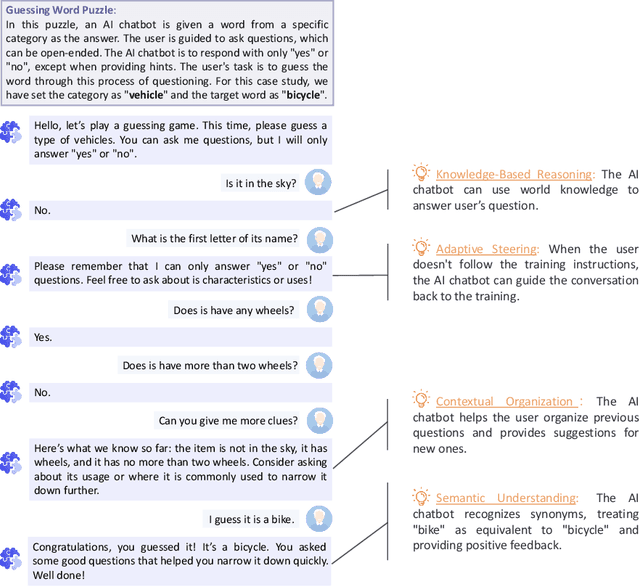Lili Qiu
Advancing Mobile GUI Agents: A Verifier-Driven Approach to Practical Deployment
Mar 21, 2025Abstract:We propose V-Droid, a mobile GUI task automation agent. Unlike previous mobile agents that utilize Large Language Models (LLMs) as generators to directly generate actions at each step, V-Droid employs LLMs as verifiers to evaluate candidate actions before making final decisions. To realize this novel paradigm, we introduce a comprehensive framework for constructing verifier-driven mobile agents: the discretized action space construction coupled with the prefilling-only workflow to accelerate the verification process, the pair-wise progress preference training to significantly enhance the verifier's decision-making capabilities, and the scalable human-agent joint annotation scheme to efficiently collect the necessary data at scale. V-Droid sets a new state-of-the-art task success rate across several public mobile task automation benchmarks: 59.5% on AndroidWorld, 38.3% on AndroidLab, and 49% on MobileAgentBench, surpassing existing agents by 9.5%, 2.1%, and 9%, respectively. Furthermore, V-Droid achieves an impressively low latency of 0.7 seconds per step, making it the first mobile agent capable of delivering near-real-time, effective decision-making capabilities.
HiTVideo: Hierarchical Tokenizers for Enhancing Text-to-Video Generation with Autoregressive Large Language Models
Mar 14, 2025Abstract:Text-to-video generation poses significant challenges due to the inherent complexity of video data, which spans both temporal and spatial dimensions. It introduces additional redundancy, abrupt variations, and a domain gap between language and vision tokens while generation. Addressing these challenges requires an effective video tokenizer that can efficiently encode video data while preserving essential semantic and spatiotemporal information, serving as a critical bridge between text and vision. Inspired by the observation in VQ-VAE-2 and workflows of traditional animation, we propose HiTVideo for text-to-video generation with hierarchical tokenizers. It utilizes a 3D causal VAE with a multi-layer discrete token framework, encoding video content into hierarchically structured codebooks. Higher layers capture semantic information with higher compression, while lower layers focus on fine-grained spatiotemporal details, striking a balance between compression efficiency and reconstruction quality. Our approach efficiently encodes longer video sequences (e.g., 8 seconds, 64 frames), reducing bits per pixel (bpp) by approximately 70\% compared to baseline tokenizers, while maintaining competitive reconstruction quality. We explore the trade-offs between compression and reconstruction, while emphasizing the advantages of high-compressed semantic tokens in text-to-video tasks. HiTVideo aims to address the potential limitations of existing video tokenizers in text-to-video generation tasks, striving for higher compression ratios and simplify LLMs modeling under language guidance, offering a scalable and promising framework for advancing text to video generation. Demo page: https://ziqinzhou66.github.io/project/HiTVideo.
VoLUT: Efficient Volumetric streaming enhanced by LUT-based super-resolution
Feb 17, 2025Abstract:3D volumetric video provides immersive experience and is gaining traction in digital media. Despite its rising popularity, the streaming of volumetric video content poses significant challenges due to the high data bandwidth requirement. A natural approach to mitigate the bandwidth issue is to reduce the volumetric video's data rate by downsampling the content prior to transmission. The video can then be upsampled at the receiver's end using a super-resolution (SR) algorithm to reconstruct the high-resolution details. While super-resolution techniques have been extensively explored and advanced for 2D video content, there is limited work on SR algorithms tailored for volumetric videos. To address this gap and the growing need for efficient volumetric video streaming, we have developed VoLUT with a new SR algorithm specifically designed for volumetric content. Our algorithm uniquely harnesses the power of lookup tables (LUTs) to facilitate the efficient and accurate upscaling of low-resolution volumetric data. The use of LUTs enables our algorithm to quickly reference precomputed high-resolution values, thereby significantly reducing the computational complexity and time required for upscaling. We further apply adaptive video bit rate algorithm (ABR) to dynamically determine the downsampling rate according to the network condition and stream the selected video rate to the receiver. Compared to related work, VoLUT is the first to enable high-quality 3D SR on commodity mobile devices at line-rate. Our evaluation shows VoLUT can reduce bandwidth usage by 70% , boost QoE by 36.7% for volumetric video streaming and achieve 3D SR speed-up with no quality compromise.
On Memory Construction and Retrieval for Personalized Conversational Agents
Feb 08, 2025Abstract:To deliver coherent and personalized experiences in long-term conversations, existing approaches typically perform retrieval augmented response generation by constructing memory banks from conversation history at either the turn-level, session-level, or through summarization techniques. In this paper, we present two key findings: (1) The granularity of memory unit matters: Turn-level, session-level, and summarization-based methods each exhibit limitations in both memory retrieval accuracy and the semantic quality of the retrieved content. (2) Prompt compression methods, such as \textit{LLMLingua-2}, can effectively serve as a denoising mechanism, enhancing memory retrieval accuracy across different granularities. Building on these insights, we propose SeCom, a method that constructs a memory bank with topical segments by introducing a conversation Segmentation model, while performing memory retrieval based on Compressed memory units. Experimental results show that SeCom outperforms turn-level, session-level, and several summarization-based methods on long-term conversation benchmarks such as LOCOMO and Long-MT-Bench+. Additionally, the proposed conversation segmentation method demonstrates superior performance on dialogue segmentation datasets such as DialSeg711, TIAGE, and SuperDialSeg.
SCBench: A KV Cache-Centric Analysis of Long-Context Methods
Dec 13, 2024



Abstract:Long-context LLMs have enabled numerous downstream applications but also introduced significant challenges related to computational and memory efficiency. To address these challenges, optimizations for long-context inference have been developed, centered around the KV cache. However, existing benchmarks often evaluate in single-request, neglecting the full lifecycle of the KV cache in real-world use. This oversight is particularly critical, as KV cache reuse has become widely adopted in LLMs inference frameworks, such as vLLM and SGLang, as well as by LLM providers, including OpenAI, Microsoft, Google, and Anthropic. To address this gap, we introduce SCBench(SharedContextBench), a comprehensive benchmark for evaluating long-context methods from a KV cachecentric perspective: 1) KV cache generation, 2) KV cache compression, 3) KV cache retrieval, 4) KV cache loading. Specifically, SCBench uses test examples with shared context, ranging 12 tasks with two shared context modes, covering four categories of long-context capabilities: string retrieval, semantic retrieval, global information, and multi-task. With it, we provide an extensive KV cache-centric analysis of eight categories long-context solutions, including Gated Linear RNNs, Mamba-Attention hybrids, and efficient methods such as sparse attention, KV cache dropping, quantization, retrieval, loading, and prompt compression. The evaluation is conducted on 8 long-context LLMs. Our findings show that sub-O(n) memory methods suffer in multi-turn scenarios, while sparse encoding with O(n) memory and sub-O(n^2) pre-filling computation perform robustly. Dynamic sparsity yields more expressive KV caches than static patterns, and layer-level sparsity in hybrid architectures reduces memory usage with strong performance. Additionally, we identify attention distribution shift issues in long-generation scenarios. https://aka.ms/SCBench.
LLM2CLIP: Powerful Language Model Unlocks Richer Visual Representation
Nov 26, 2024



Abstract:CLIP is a foundational multimodal model that aligns image and text features into a shared space using contrastive learning on large-scale image-text pairs. Its strength lies in leveraging natural language as a rich supervisory signal. With the rapid progress of large language models (LLMs), we explore their potential to further enhance CLIP's multimodal representation learning. This work introduces a fine-tuning approach that integrates LLMs with the pretrained CLIP visual encoder, leveraging LLMs' advanced text understanding and open-world knowledge to improve CLIP's ability to process long and complex captions. To address the challenge of LLMs' autoregressive nature, we propose a caption-to-caption contrastive learning framework to enhance the discriminative power of their outputs. Our method achieves substantial performance gains on various downstream tasks, demonstrating the effectiveness of combining LLMs with CLIP for enhanced multimodal learning.
LLM2CLIP: Powerful Language Model Unlock Richer Visual Representation
Nov 07, 2024



Abstract:CLIP is one of the most important multimodal foundational models today. What powers CLIP's capabilities? The rich supervision signals provided by natural language, the carrier of human knowledge, shape a powerful cross-modal representation space. However, with the rapid advancements in large language models LLMs like GPT-4 and LLaMA, the boundaries of language comprehension and generation are continually being pushed. This raises an intriguing question: can the capabilities of LLMs be harnessed to further improve multimodal representation learning? The potential benefits of incorporating LLMs into CLIP are clear. LLMs' strong textual understanding can fundamentally improve CLIP's ability to handle image captions, drastically enhancing its ability to process long and complex texts, a well-known limitation of vanilla CLIP. Moreover, LLMs are trained on a vast corpus of text, possessing open-world knowledge. This allows them to expand on caption information during training, increasing the efficiency of the learning process. In this paper, we propose LLM2CLIP, a novel approach that embraces the power of LLMs to unlock CLIP's potential. By fine-tuning the LLM in the caption space with contrastive learning, we extract its textual capabilities into the output embeddings, significantly improving the output layer's textual discriminability. We then design an efficient training process where the fine-tuned LLM acts as a powerful teacher for CLIP's visual encoder. Thanks to the LLM's presence, we can now incorporate longer and more complex captions without being restricted by vanilla CLIP's text encoder's context window and ability limitations. Our experiments demonstrate that this approach brings substantial improvements in cross-modal tasks.
The Potential and Value of AI Chatbot in Personalized Cognitive Training
Oct 25, 2024


Abstract:In recent years, the rapid aging of the global population has led to an increase in cognitive disorders, such as Alzheimer's disease, presenting significant public health challenges. Although no effective treatments currently exist to reverse Alzheimer's, prevention and early intervention, including cognitive training, are critical. This report explores the potential of AI chatbots in enhancing personalized cognitive training. We introduce ReMe, a web-based framework designed to create AI chatbots that facilitate cognitive training research, specifically targeting episodic memory tasks derived from personal life logs. By leveraging large language models, ReMe provides enhanced user-friendly, interactive, and personalized training experiences. Case studies demonstrate ReMe's effectiveness in engaging users through life recall and open-ended language puzzles, highlighting its potential to improve cognitive training design. Despite promising results, further research is needed to validate training effectiveness through large-scale studies that include cognitive ability evaluations. Overall, ReMe offers a promising approach to personalized cognitive training, utilizing AI capabilities to meet the growing demand for non-pharmacological interventions in cognitive health, with future research aiming to expand its applications and efficacy.
RetrievalAttention: Accelerating Long-Context LLM Inference via Vector Retrieval
Sep 16, 2024



Abstract:Transformer-based large Language Models (LLMs) become increasingly important in various domains. However, the quadratic time complexity of attention operation poses a significant challenge for scaling to longer contexts due to the extremely high inference latency and GPU memory consumption for caching key-value (KV) vectors. This paper proposes RetrievalAttention, a training-free approach to accelerate attention computation. To leverage the dynamic sparse property of attention, RetrievalAttention builds approximate nearest neighbor search (ANNS) indexes upon KV vectors in CPU memory and retrieves the most relevant ones via vector search during generation. Due to the out-of-distribution (OOD) between query vectors and key vectors, off-the-shelf ANNS indexes still need to scan O(N) (usually 30% of all keys) data for accurate retrieval, which fails to exploit the high sparsity. RetrievalAttention first identifies the OOD challenge of ANNS-based attention, and addresses it via an attention-aware vector search algorithm that can adapt to queries and only access 1--3% of data, thus achieving a sub-linear time complexity. RetrievalAttention greatly reduces the inference cost of long-context LLM with much lower GPU memory requirements while maintaining the model accuracy. Especially, RetrievalAttention only needs 16GB GPU memory for serving 128K tokens in LLMs with 8B parameters, which is capable of generating one token in 0.188 seconds on a single NVIDIA RTX4090 (24GB).
Advancing Multi-Modal Sensing Through Expandable Modality Alignment
Jul 25, 2024Abstract:Sensing technology is widely used for comprehending the physical world, with numerous modalities explored in past decades. While there has been considerable work on multi-modality learning, they all require data of all modalities be paired. How to leverage multi-modality data with partially pairings remains an open problem. To tackle this challenge, we introduce the Babel framework, encompassing the neural network architecture, data preparation and processing, as well as the training strategies. Babel serves as a scalable pre-trained multi-modal sensing neural network, currently aligning six sensing modalities, namely Wi-Fi, mmWave, IMU, LiDAR, video, and depth. To overcome the scarcity of complete paired data, the key idea of Babel involves transforming the N-modality alignment into a series of two-modality alignments by devising the expandable network architecture. This concept is also realized via a series of novel techniques, including the pre-trained modality tower that capitalizes on available single-modal networks, and the adaptive training strategy balancing the contribution of the newly incorporated modality with the previously established modality alignment. Evaluation demonstrates Babel's outstanding performance on eight human activity recognition datasets, compared to various baselines e.g., the top multi-modal sensing framework, single-modal sensing networks, and multi-modal large language models. Babel not only effectively fuses multiple available modalities (up to 22% accuracy increase), but also enhance the performance of individual modality (12% averaged accuracy improvement). Case studies also highlight exciting application scenarios empowered by Babel, including cross-modality retrieval (i.e., sensing imaging), and bridging LLM for sensing comprehension.
 Add to Chrome
Add to Chrome Add to Firefox
Add to Firefox Add to Edge
Add to Edge